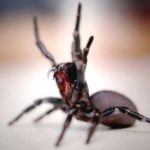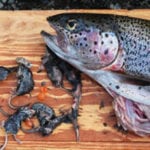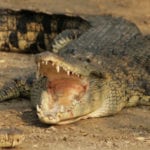 Miscellaneous
Miscellaneous  Miscellaneous
Miscellaneous  Our World
Our World 10 Green Practices That Actually Make a Difference
 Humans
Humans Ten Historic Men Who Deserve Way More Credit Than They Got
 Movies and TV
Movies and TV The 10 Most Heartwarming Moments in Pixar Films
 Travel
Travel Top 10 Religious Architectural Marvels
 Creepy
Creepy 10 Haunted Places in Alabama
 History
History Top 10 Tragic Facts about England’s 9 Days Queen
 Food
Food 10 Weird Foods Inspired by Your Favorite Movies
 Religion
Religion 10 Mind-Blowing Claims and Messages Hidden in the Bible Code
 Facts
Facts 10 Things You Never Knew about the History of Gambling
 Miscellaneous
Miscellaneous Ten Groundbreaking Tattoos with Fascinating Backstories
 Our World
Our World 10 Green Practices That Actually Make a Difference
 Humans
Humans Ten Historic Men Who Deserve Way More Credit Than They Got
Who's Behind Listverse?

Jamie Frater
Head Editor
Jamie founded Listverse due to an insatiable desire to share fascinating, obscure, and bizarre facts. He has been a guest speaker on numerous national radio and television stations and is a five time published author.
More About Us Movies and TV
Movies and TV The 10 Most Heartwarming Moments in Pixar Films
 Travel
Travel Top 10 Religious Architectural Marvels
 Creepy
Creepy 10 Haunted Places in Alabama
 History
History Top 10 Tragic Facts about England’s 9 Days Queen
 Food
Food 10 Weird Foods Inspired by Your Favorite Movies
 Religion
Religion 10 Mind-Blowing Claims and Messages Hidden in the Bible Code
 Facts
Facts 10 Things You Never Knew about the History of Gambling
Top 10 Deadliest Animals
Danger and especially dangerous creatures fascinate us. The subject has appeared on more than one occasion on Listverse for this reason. Today’s list is a little different than the others though, in that it examines ten different criteria for what makes an animal deadly. Many more criteria are still out there. Feel free to add other deadly creatures to the comments.

The king of the jungle is a title that still misleadingly belongs to the elephant, not the lion. Neither of them lives in any jungle in Africa. The African elephant is the largest land animal on Earth and has zero natural predators (man doesn’t count as natural). The ones you’ve seen in zoos are simply not the same as those in the wild. In zoos, elephants know humans are no threat; in the wild, any animal that is not a herbivore is a threat, and elephants are smart enough to know which is which.
In the wild, they are docile to a point. You may stand 100 meters from one and it will pay attention but not attack. Or it may charge you from 500 meters as soon as it sees you. Of course the largest land animal is sure to be also the most powerful, and the elephant is, but it possesses an intelligence that may rival that of some primates. This is not quite so difficult to fathom given that it has an 11-pound brain.
The elephant is the grandest of the Big Five game animals of Africa, and although it is still legal to hunt them, a license to kill just one will cost about $50,000. Hunters are only permitted to kill solitary old bulls or cows that are not long from natural death. The money goes to conservation efforts. Despite their size, they disappear very easily in tall brush and their ears enable them to hear you long before you hear them. Their olfactory sense is extraordinary, enabling them to smell you from 1 mile. And because they are gargantuan, they generally do not run away or hide. Full-grown elephants have zero natural predators. Nothing dares tangle with them. They can run 25 miles an hour for 100 meters, which is faster than Usain Bolt.
They are hyper-aggressive during musth. Musth is the bull elephant’s reproductive hormones, mostly testosterone, all of which rise 60 times higher than normal. This makes the elephant want to mate with any cow it sees, and fight everything else. Musth causes the bull extreme irritation and puts him in a severely foul mood.
It is during musth that bulls have been known to charge through 2 direct hits from a .460 Weatherby Magnum (ordinarily more than sufficient to drop one in its tracks), and trample the hunter to death, flip safari jeeps and gore through chassis; 6-ton bulls have been witnessed flinging black rhinoceros 14 feet over their heads, kicking down 4-foot-thick trees, and snapping anchor chains used to hold them. They are smart enough to angle their tusks into the chain links and pop them loose if they cannot overpower the iron.

The tiger is slightly larger than, and just as fast as, the lion, but the lion just edged out the tiger because the lion is the only cat known to science that works as a team with other lions to hunt. This enables it to bring down prey far larger than itself. Lions are possibly the smartest of cats; the members of a pride will stealthily arrange themselves around a herd of prey animals, and when the ambushers are in position, they signal to the drivers with a cough or sneeze, whereupon the prey is driven into an ambush and several are brought down, saving the lions from a drawn-out chase.
A full-grown male lion is about 6 inches taller than a tiger and weighs anywhere from 330 to 550 lbs (150-250 kgs), averaging 400. This size makes it sound as though the lion should be ungainly, but the opposite is true. He can charge 50 mph for over 100 meters. Male lions have been seen jumping 4-rail fences with cows in their mouths. They can spring 12 feet straight up into the air and leap 40-foot gorges. Their mortal enemy, the hyena, is no match for them one on one, but even when they attack in packs, a single male lion can stand his ground admirably.
Video shows a pride of lionesses being robbed of its kill by a pack of hyenas, and then killing more prey, only to be robbed again. The lionesses finally “complained” to the male in charge by grunting at him until he woke up. He saw the hyenas eating within 200 meters, walked to within 50 meters of them, then charged and killed 9 of them before the rest fled. One swipe of his forepaw cut one in half across the spine.
Lions have been known to slash the tires of safari jeeps to immobilize them and the tourists inside. To ward them off, the guides play recordings of elephants trumpeting. Hunting them is still legal, but conservation makes it expensive (as it should), and only old specimens or man-eaters are taken. The two most infamous remain the Tsavo maneless man-eaters of 1898. From March to December, they killed and ate as many as 135 railway workers in Tsavo, Kenya. They were gigantic, even for lions, measuring 9 feet, 8 inches, and 9 feet, 6 inches long, and required 8 men to carry them. Their hunter, Col. John Patterson, shot the second no less than 8 times with a .303 Lee-Enfield, which has power comparable to the .30-06, before the lion succumbed.
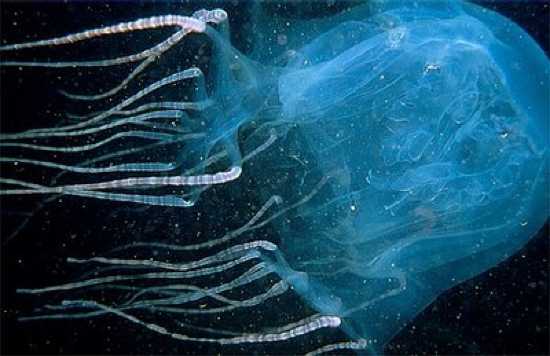
Everyone is always asking what animal packs the deadliest venom in the world. Here, once and for all, are the two answers. Sea life has abounded for about 3 billion years longer than life on land, and the longer nature has to evolve its animals, the nastier, deadlier, more perfect (see #4) they get. There are many species of box jellies, but Chironex fleckeri, also called the sea wasp, is by far the most notorious.
It can weigh up to 4 and half pounds (2 kgs), with a bell that can reach the size of a basketball, with 15 tentacles up to 10 feet long beneath. Its infamous venom was once thought to glow in the dark, but cannot. Instead, the venom absorbs and reflects the slightest sunlight into and out from the tentacles, giving the jelly an ethereal glow even at twilight. Luckily, this enables you to see it coming. It uses its venom to immobilize fish, and if you were to become wrapped within the tentacles long enough, it would dissolve you.
At night, they simply sit on the seafloor. During the day, it hunts for shrimp, minnows, and other small fish. Sea turtles are able to eat box jellies and do frequently. They have extremely thick skin that shields them from the stings. If you are stung only slightly by a sea wasp jelly, you will not die, but you will wish you would. The pain is described as “excruciating,” “exquisite,” “beyond belief.” Children do not cry when they are stung. They scream. Lifeguards have claimed that simply cutting off the limb that has been stung would hurt less than leaving it attached.
If you were to be wrapped up in the jelly’s tentacles, which happens quite often off the northern coast of Australia, the cnidocytes in the venom would stop your heart in 3 minutes. That is 180 seconds. This assumes you do not drown before escaping the sea, because the venom also shuts down the brain’s communication with the muscles. The sea wasp has killed 63 people since 1884, most of them off Australia. Its range extends at least into the Philippines, to Malaysia.
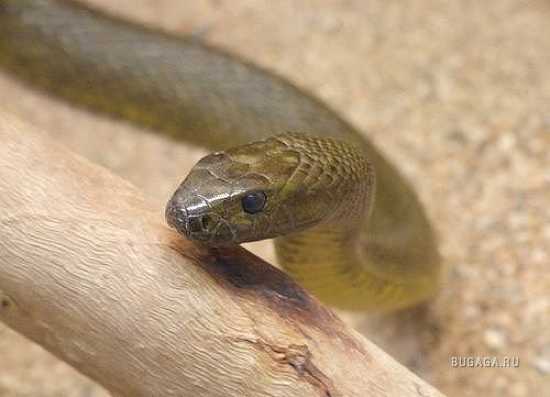
The inland taipan must not be confused with the coastal taipan or the central taipan, all three of which are highly venomous. The inland taipan, also called the fierce snake (for its venom), the small-scaled snake, and the two-step snake, averages 6 feet long, with a maximum recorded of 8.2 feet. They are extremely shy and always try to escape any large animal’s presence. It is only by cornering one that it bites.
The median lethal dose of its venom is 30 micrograms per kilogram. It injects an average of 44 milligrams per bite, which is 44,000 micrograms. It can inject up to 110 milligrams. The snake has, however, never actually been known to kill a human. This is because its habitat is in the center of the Australian outback, where very few humans ever bother to venture, and also because you have to work very hard to make it bite. Its diet consists entirely of rodents, and it does not strike once and then wait for the prey to succumb. It bites up to 8 times to hasten the process.
The venom itself is comprised of taipoxin, named after the snake. This is one of the most powerful natural toxins ever known, and stops the brain’s communication with the muscles, causing death by asphyxia. Antivenin is 100% successful, provided that you don’t have 200 miles to travel to a hospital. A bite on the calf, injecting 44 mgs, will drop a 200 pound human within 300 meters of running or 45 minutes of resting pulse. Herpetologists have claimed that, provided it were devenomized, the snake would make an outstanding aquarium pet given its docile temperament.

Have you noticed that most history books divide eras among major social, political, or disastrous events and that the lion’s share of these are wars? In 200,000 years of the modern human species’ history (our personal history), the only thing we’ve been able to do consistently well is kill each other. All animals fight, but only humans wage war. We are the only species that has ever existed on Earth to have attempted the elimination of entire species. And we are always getting better at it, always pushing scientific knowledge, and almost always one of the first things for which science is put to use is the invention of new methods of murder.
We do it so well that we cannot even face ourselves when we consider it. We devise euphemisms, especially in time of war: it’s not murder – it’s combat, or “defending our freedom,” “target neutralization,” “justifiable homicide,” “soldiery,” “just following orders.”
The human is the only animal ever known to be capable of revenge, hatred, or sadism, and we are intimate with all three. We kill for every reason.
Black powder was originally invented by Chinese alchemists looking for the elixir of life, then used as a means to set off fireworks for amusement. That didn’t last long. Now it is more commonly called gunpowder.
The Wright Brothers pioneered human aviation for the purpose of enabling aerial warfare, because in their opinion this would make national invasions impossible, and would thus negate all warfare in the first place. Wishful thinking. Tesla envisioned his “death beam” for the same purpose. Einstein had no idea his Special Theory of Relativity could be used to split atoms for the purpose of killing people. When Robert Oppenheimer and Enrico Fermi explained to him what was being done at The Manhattan Project, he burst into tears.
Consider all the kindhearted, nonviolent people through the ages, Jesus, Gandhi, Martin Luther King. What do we do to them? Hate them, harm them, kill them out of spite.
The human is an unnatural animal because of all this. It does not fit into any environment, except perhaps the urban environment. We think of ourselves as predators, usually with a sense of pride. Nevertheless, on even terms, the human would not stand half a chance in a fight to the death with most of the other entries on this list. But that only incites us to pick the fight, and we do so by the one method in which we have no equals: thinking. Given the proper preparation (typically guns), we are more than a match for any other organism on this list. And that fills us with malicious and/or “sporting” glee.
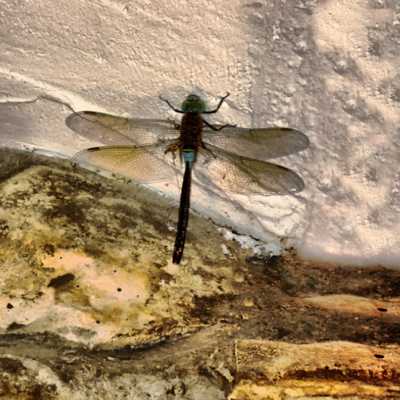
The mosquito is possibly responsible for more deaths throughout history than any other macroscopic animal. They’re easy to kill, but typically not until they bite you. Then you smack them but the damage is done. Usually, all that happens is you itch for a little while. This is because the mosquito’s saliva contains histamines, which irritate the skin.
The reason they are extremely dangerous is because they transmit diseases infectious to humans and livestock, many of them fatal without treatment. Malaria is the most well-known, which can kill 20% of the time in severe cases, even with treatment. They also transmit West Nile Virus, lymphatic filariasis (roundworms), tularemia, dengue fever, yellow fever, and others. All of these can kill.
In addition to the lethal diseases they carry, mosquitoes can kill on their own. They are feared throughout the Australian outback (just one more reason not to go there) and the southern Sahara, where shallow deluges provide them excellent breeding in the water. When the larvae hatch, they attack in swarms of over 1 billion insects, descending on cows and camels and draining them of blood within 10 minutes.

As mentioned in #8, nature has perfected ocean life. The shark has zero natural predators, except perhaps larger sharks. The largest is the whale shark, but it eats small fish, plankton, and krill. The largest macro predatory shark is the one Steven Spielberg made permanently infamous in “Jaws,” the Great White. In that film, the shark is summed up by Richard Dreyfuss, “All it does is swim, and eat, and make little sharks.” It can reach over 20 feet long, easily weigh 2.5 tons, and still swim 35 feet per second. Michael Phelps set the world record of 100 meters in freestyle at 47.82 seconds. This works out to about 4.7 miles per hour. The Great White can swim 25 miles per hour.
All sharks have a superlative sense of smell to make up for their bad eyesight. Any species can smell a drop of blood in an Olympic swimming pool. They can smell a bleeding swimmer from 5 miles, and with a single bite can tear off 31 lbs of flesh. In theory, sharks are always hungry, and a 20 foot specimen can bite with 4,000 pounds of force, which is more powerful than the impact of a .375 H & H Magnum rifle round.
The shark’s most incredible, virtually X-Men ability is called electroreception. They have organs in their heads called Ampullae of Lorenzini. Every time any animal moves, it generates a very slight electrical field, and sharks can actually sense this electricity. Thus a person treading water looks like lightning to a shark. A great white can detect half a billionth of a single volt. If it is within 100 meters, it can detect the voltage of your heartbeat.
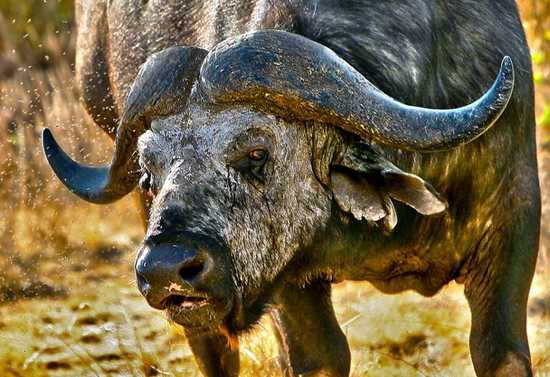
The cape buffalo is by far the most dangerous game animal on Earth. It is sufficiently thick-skinned to require an elephant rifle, and is the animal most responsible for the introduction of double-barreled rifles. A double-barreled rifle offers the hunter an immediate follow-up shot to finish a wounded animal, and cape buffaloes can be counted on to withstand the first shot, even if they are struck in the heart, and still charge. The .585 Nyati caliber was invented for use against this animal. Nyati is Swahili for Cape Buffalo.
You may think touring Africa’s grasslands in a safari jeep is safe, and were it not for the Cape Buffalo, you would be fairly correct. They may charge without any provocation at all, and they overturn jeeps, trucks, and vans by ramming them headfirst. A 2,000 lb male can run 40 miles an hour for more than 100 meters. Some professional hunting guides refuse to hunt them, for fear the paying hunter will miss. The cape buffalo gores and tramples to death over 200 people every year, more kills, possibly, than any other African animal.
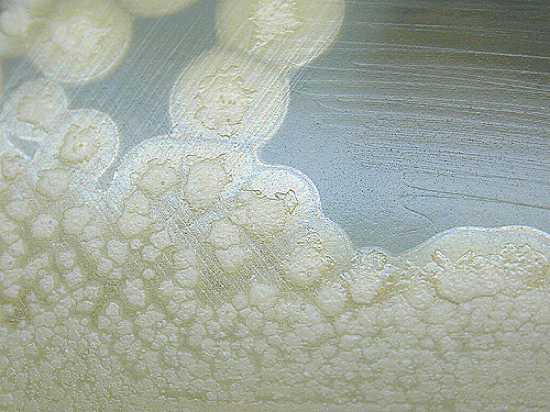
One teaspoon of this bacterium, properly distributed, could kill every single human being in the United States. About 9 lbs (4 kgs) could kill every human in the world. Like the venom of #7, botulinum is a neurotoxin, stopping communication between the brain and the muscles, resulting in paralysis of the diaphragm, then asphyxia.
Botulinum is found in the soil of every continent and ecosystem on Earth, from the Sahara Desert to Antarctica. It is found in soil brought up from the ocean floor. It requires absolutely perfect conditions in order to become active and thus dangerous. You would not be able to contract the toxin by eating dirt, since your digestive juices are too acidic to allow the bacterium to grow and produce the toxin.
But the spores are extraordinarily difficult to kill, able to survive in boiling water for 10 minutes. If you were to can food without boiling it (cold canning), airborne spores may enter the oxygen-free environment of the food and grow very quickly. Upon eating the food, the toxins would be present in your body immediately, and eating only a nibble of a green bean is more than sufficient to kill you within a day. No animal is known to have an immunity to botulinum. A mere 1 nanogram per kilogram dose will kill any living organism on the planet. An elephant weighing 5,454 kgs (12,000 lbs) would die in less than 3 days after consuming 5,454 ngs of botulinum toxin. This is equal to 0.005454 milligrams.

Let’s face it. Africa is an extremely dangerous place and anything can die there very easily. Siafu ants are also called driver ants, safari ants, and army ants. They live primarily in central and east Africa, both in jungle and on savanna. They have no eyes. They communicate and navigate by smelling pheromones, and every few years a colony of 50,000,000 will decide to pick up and move in search of more fruitful hunting grounds.
When they move, they form columns on the ground, with the smaller worker ants inside a tunnel formed by the larger soldier or guard ants. The ants average about an inch long, with the winged males the largest ant known at over 2 inches. They have venom and can sting with their abdomens, but it is insufficient to kill large animals. Instead, they rely on their bite. They have mandibles strong enough to cut through rhinoceros hide. And when the colony relocates, every animal in the entire area of many square miles, including the honey badger, leaves and may not return for weeks.
If one ant attacked you, you could stomp it or pick it off you. But ants don’t play fair. If you come within 25 meters of a colony on the move in column formation, they will smell you and come running to defend themselves. The bite is severely painful and once blood is drawn, your only defense is to run for your life. Attacking the ants is useless. A flamethrower might work but the ants do not know the use of fear and will either run across fiery ground to get at you, or wait until the fire dies away.
They do not run fast and are easy to avoid, provided you are able to get away. They are able to overpower any known animal, having brought down sick or injured elephants that could not escape. They have killed many people over the centuries, always infants or the injured, those who are unable to run. Once they are upon you, there is no easy way to get them off. Other ants will let go if you submerge in water. Siafu ants will hold their breath and bite for 3 minutes under water. A colony can strip an elephant to the bone in a month, and during that time nothing else except bacteria can approach the carcass. Vultures land on it and immediately fly away kicking ants off their feet.
They are used as natural stitches by the indigenous peoples. A single ant is picked up and allowed to bite on either side of a wound, and then the body is pinched off, leaving the head with jaws locked shut. They have venomous stings but hardly ever use them. They kill prey such as grasshoppers and small rodents simply by biting them to death. What they do is overwhelm any animal they can find and bite until the animal is incapacitated by agony. Smaller animals like insects are cut to pieces. The ants will enter the mouth of a larger animal and invade the lungs, biting the whole way, causing death by asphyxia.

